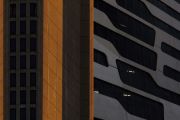
Fears of more student beds, no guaranteed affordable housing at The Block in Redfern
Carrie Fellner
Towers up to 24-storeys high – housing up to 600 students – are now being proposed for The Block in Redfern, with no guarantees that affordable housing promised for Indigenous families will eventuate.
In an October report, the Department of Planning warned it had not received concrete evidence that affordable housing would proceed as part of the $70 million development.
The Aboriginal Housing Company (AHC), which owns the site, and developer Deicorp have increased the lucrative student housing portion of the development, known as the Pemulwuy Project.
Last March they proposed a multi-tower development up to 16-storeys high for 500 university students, in addition to the affordable housing for 62 Aboriginal families, a gym, retail and a childcare centre. Now their latest plans are for the 24-storey high towers to accommodate up to 600 students.
In assessing the project, the department recommended its approval. However, it warned that the developers had failed to present concrete evidence the affordable housing portion of the development would go ahead.
“There is currently no restriction on title guaranteeing the 62 dwellings … being provided as affordable housing,” the report said.
“AHC is not yet registered as a community housing provider and a housing provider has not been nominated.”
The comments follow a request by Deicorp to have its developer fees waived due to the project’s public benefit.
Deicorp argued it should be exempt due to the open space, public art, $28 million in affordable housing and $3.5 million childcare centre included in the plans.
But the department found the applicant had “not provided any evidence to support the predicted costs” and needed to provide firmer guarantees.
Meanwhile, the federal government has revealed that the Aboriginal Housing Company turned down a $5 million grant to ensure affordable housing was part of the development.
An AHC spokesman denied it had knocked back the grant.
“The affordable housing component will be built first ensuring the community realises true benefit at the earliest stage possible,” he said.
Tensions have reignited within the Aboriginal community over the student housing plans.
“None of this is justified and none of this is right,” said Jenny Munro, a Wiradjuri elder and vocal opponent of the plans.
“How can the Aboriginal Housing Company even call itself an Aboriginal Housing Company? It’s actually an Asian student housing company, for all intents and purposes,” she said.
A bitter feud over the proposal first erupted in 2015 after the AHC took court action to evict an Aboriginal tent embassy camped on the site.
The protestors accused the AHC of pursuing profit over the interests of the community.
At the time, AHC chief executive Mick Mundine insisted the construction of the affordable housing would not be viable without first building the commercial portion.
A peace deal was brokered by Indigenous Affairs Minister Nigel Scullion, who offered the AHC a $5 million grant to secure a loan to guarantee the affordable housing would be built from the outset.
When asked about the status of the grant, the AHC spokesperson said it would become available once the organisation “receives the certificate of occupation”.
But a spokesperson for Mr Scullion said the offer was ultimately not accepted.
“The Aboriginal Housing Company announced in 2017 it had instead partnered with student accommodation provider Atira to develop a new funding model that would allow it to deliver on the core objectives of the Pemulwuy project,” he said.
A final decision on the project will be made by the Independent Planning Commission, which will hold a public hearing on Thursday. Ms Munro said she had not been contacted about the meeting.
“I’m the biggest thorn in their side, why would they want me there?” she said.
The panel will consider 183 public submissions on the proposal, including 171 objections. Of the greatest concern were the height, scale and character of the development.
Among the objectors was the Heritage Council, which argued the student housing should be no higher than six storeys and the bold design was “intrusive” and risked “overwhelming” neighbouring Redfern station.












